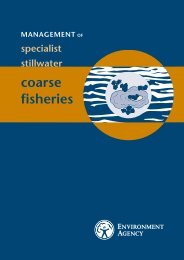Soil Guideline Values for cadmium in soil (PDF, 188 KB)
Soil Guideline Values for cadmium in soil (PDF, 188 KB)
Soil Guideline Values for cadmium in soil (PDF, 188 KB)
You also want an ePaper? Increase the reach of your titles
YUMPU automatically turns print PDFs into web optimized ePapers that Google loves.
The current practice <strong>in</strong> most European countries<br />
<strong>in</strong>volves the electrolytic treatment of <strong>cadmium</strong> sulphate<br />
solution collected dur<strong>in</strong>g the production of z<strong>in</strong>c (ECB,<br />
2007).<br />
Between 2000 and 2002, about 1,100 tonnes per year of<br />
<strong>cadmium</strong> was produced by European countries with a<br />
further 1,700 tonnes per year imported from outside the<br />
European Union (ECB, 2007).<br />
A small but important proportion of <strong>cadmium</strong>, primarily<br />
from batteries, is recycled (ECB, 2007).<br />
Cadmium oxide is an important <strong>in</strong>dustrial chemical,<br />
manufactured by the reaction of metal vapour with air<br />
(ECB, 2007). About 4,500 tonnes per year of <strong>cadmium</strong><br />
oxide were produced across the European Union<br />
between 2000 and 2002 (ECB, 2007).<br />
Cadmium metal, its alloys and compounds have been<br />
used <strong>in</strong> a variety of different <strong>in</strong>dustrial and consumer<br />
products, although most uses are now decl<strong>in</strong><strong>in</strong>g due to<br />
concerns about its toxicity (ATSDR, 2008). Currently,<br />
most <strong>cadmium</strong> is used <strong>in</strong> the production of nickel–<br />
<strong>cadmium</strong> batteries <strong>for</strong> <strong>in</strong>dustrial and commercial use<br />
although alternative products such as lithium ion<br />
batteries have eroded their market share <strong>in</strong> recent years<br />
(ECB, 2007; ATSDR, 2008). Cadmium is also still used<br />
as a semi-conductor and a photo-conductor <strong>in</strong> solar cells<br />
and other electronic devices (ATSDR, 2008).<br />
Cadmium has also been used <strong>in</strong> pigments <strong>for</strong> plastics,<br />
glass and ceramics, as a fungicide, <strong>in</strong> stabilisers <strong>for</strong><br />
plastics <strong>in</strong>clud<strong>in</strong>g PVC, and <strong>in</strong> corrosion-resistant<br />
coat<strong>in</strong>gs on steel and other non-ferrous metals; it has<br />
other m<strong>in</strong>or applications <strong>for</strong> photography, photocopy<strong>in</strong>g,<br />
dye<strong>in</strong>g, calico pr<strong>in</strong>t<strong>in</strong>g, vacuum tube manufacture,<br />
galvanoplasty, lubricants, ice-nucleation agents, and <strong>in</strong><br />
the manufacture of special mirrors (Alloway, 1995; ECB,<br />
2007; Kabata-Pendias and Mukherjee, 2007; ATSDR,<br />
2008).<br />
Accord<strong>in</strong>g to a mass balance analysis of production,<br />
imports and exports <strong>for</strong> the period 2000 to 2002, the<br />
European Union used around 2,300 tonnes of <strong>cadmium</strong><br />
with some 80 per cent used to make Ni–Cd batteries,<br />
and the rema<strong>in</strong><strong>in</strong>g 20 per cent used <strong>for</strong> pigments,<br />
stabilisers, and alloys/metal plat<strong>in</strong>g (ECB, 2007).<br />
Potential harm to human health<br />
The pr<strong>in</strong>ciples beh<strong>in</strong>d the selection of Health Criteria<br />
<strong>Values</strong> (HCVs), and the def<strong>in</strong>ition of concepts and terms<br />
used, are outl<strong>in</strong>ed <strong>in</strong> Human health toxicological<br />
assessment of contam<strong>in</strong>ants <strong>in</strong> <strong>soil</strong> (Environment<br />
Agency, 2009c). Specific <strong>in</strong><strong>for</strong>mation on the toxicity of<br />
<strong>cadmium</strong> and its compounds is reviewed <strong>in</strong><br />
Contam<strong>in</strong>ants <strong>in</strong> <strong>soil</strong>: updated collation of toxicological<br />
data and <strong>in</strong>take values <strong>for</strong> humans. Cadmium<br />
(Environment Agency, 2009d) and only a brief summary<br />
is presented here.<br />
Follow<strong>in</strong>g long-term exposure to <strong>cadmium</strong>, the ma<strong>in</strong><br />
health concerns are its toxicity to the kidney and bones,<br />
aris<strong>in</strong>g via <strong>in</strong>gestion and <strong>in</strong>halation, and its lung<br />
carc<strong>in</strong>ogenicity seen <strong>in</strong> exposed workers follow<strong>in</strong>g<br />
<strong>in</strong>halation (Environment Agency, 2009d).<br />
Over a period of time, <strong>cadmium</strong> accumulates <strong>in</strong> the<br />
kidney and, if the organ concentration exceeds a critical<br />
threshold, the tubule cells become damaged and renal<br />
function impaired (Environment Agency, 2009d).<br />
This <strong>cadmium</strong> build-up also affects vitam<strong>in</strong> D<br />
metabolism, disturb<strong>in</strong>g the calcium balance with<strong>in</strong> the<br />
body, which may lead to a decrease <strong>in</strong> the m<strong>in</strong>eral<br />
content with<strong>in</strong> the bones, result<strong>in</strong>g <strong>in</strong> osteoporosis and<br />
osteomalacia (Environment Agency, 2009d).<br />
The oral tolerable daily <strong>in</strong>take (TDIoral), which is based<br />
on an evaluation by the European Food Safety Authority<br />
(EFSA), is protective of renal and bone health effects<br />
(Environment Agency, 2009d).<br />
The <strong>in</strong>halation tolerable daily <strong>in</strong>take (TDI<strong>in</strong>h), which is<br />
based on the proposal of a European Commission<br />
Table 1<br />
Recommended Health Criteria <strong>Values</strong> and estimated<br />
background adult <strong>in</strong>takes <strong>for</strong> <strong>in</strong>organic compounds of<br />
<strong>cadmium</strong> (Environment Agency, 2009d)<br />
Parameter Cadmium<br />
TDIoral, µg kg -1 bw day -1 0.36<br />
MDIoral, µg day -1 13.4<br />
TDI<strong>in</strong>h, µg kg -1 bw day -1 0.0014<br />
MDI<strong>in</strong>h, µg day -1 0.02<br />
Notes<br />
bw = bodyweight<br />
TDI = tolerable daily <strong>in</strong>take<br />
MDI = mean daily <strong>in</strong>take<br />
Work<strong>in</strong>g Group, is aga<strong>in</strong> protective of renal health<br />
effects. Exposure at this level is expected to pose a<br />
m<strong>in</strong>imal risk of lung cancer (Environment Agency,<br />
2009d).<br />
Health Criteria <strong>Values</strong> (HCVs) <strong>for</strong> <strong>cadmium</strong> and its<br />
<strong>in</strong>organic compounds are summarised <strong>in</strong> Table 1.<br />
The adult oral mean daily <strong>in</strong>take (MDIoral) <strong>for</strong> <strong>cadmium</strong> is<br />
estimated at 13.4 µg day -1 . The adult <strong>in</strong>halation mean<br />
daily <strong>in</strong>take (MDI<strong>in</strong>h) is approximately 0.02 µg day -1<br />
(Environment Agency, 2009d).<br />
The effects of dermal exposure to <strong>cadmium</strong> are not<br />
expected to be significant and no expert group<br />
derivations of HCVs <strong>for</strong> dermal exposure were identified<br />
(Environment Agency, 2009d). Dermal absorption<br />
appears to be lower than oral absorption and, on this<br />
basis, it would seem reasonable to assume that the oral<br />
TDI <strong>for</strong> deriv<strong>in</strong>g SGVs could be used <strong>for</strong> an <strong>in</strong>itial<br />
conservative dermal risk assessment, <strong>in</strong> l<strong>in</strong>e with<br />
Environment Agency (2009c).<br />
Oral, dermal and <strong>in</strong>halation exposures contribute to the<br />
same systemic effects on the kidney and bone;<br />
there<strong>for</strong>e, this should also be considered <strong>in</strong> a risk<br />
assessment.
















